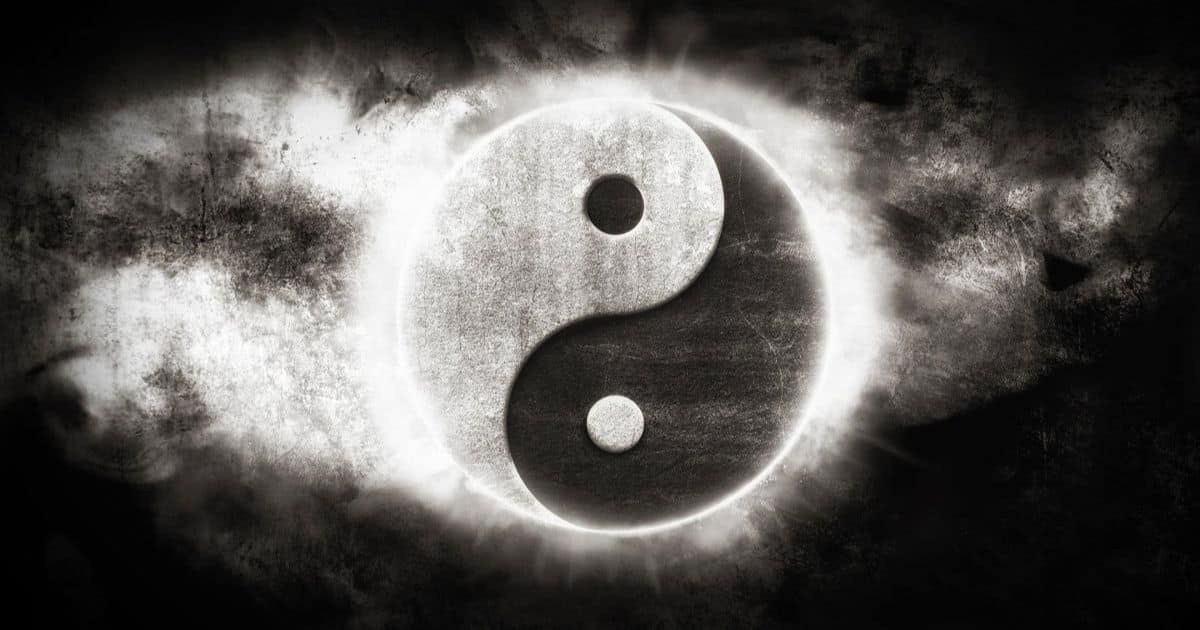In a world characterized by chaos and constant movement, finding balance and harmony has become a universal quest. From ancient philosophies to modern wellness practices, the concept of balance permeates every aspect of our lives. One symbol that embodies this timeless pursuit is the Yin Yang symbol, a striking visual representation of the interconnectedness and harmony of opposing forces.
Yin Yang necklaces have emerged as a powerful fashion statement, not only for their aesthetic appeal but also for the profound meaning they hold. These necklaces serve as a tangible reminder of the delicate dance between light and dark, masculine and feminine, strength and vulnerability. More than just an accessory, they encapsulate the essence of balance, offering wearers a deeper understanding of themselves and their place in the world.
In this ultimate guide to stylish balance, we will explore the meaning and benefits of Yin Yang necklaces, delving into the rich symbolism they carry and the impact they can have on our lives. From their historical origins rooted in Eastern philosophy to their contemporary interpretations, we will unravel the fascinating story behind these captivating pieces of jewelry. Join us on this journey of self-discovery and style as we unlock the secrets of the Yin Yang necklace.
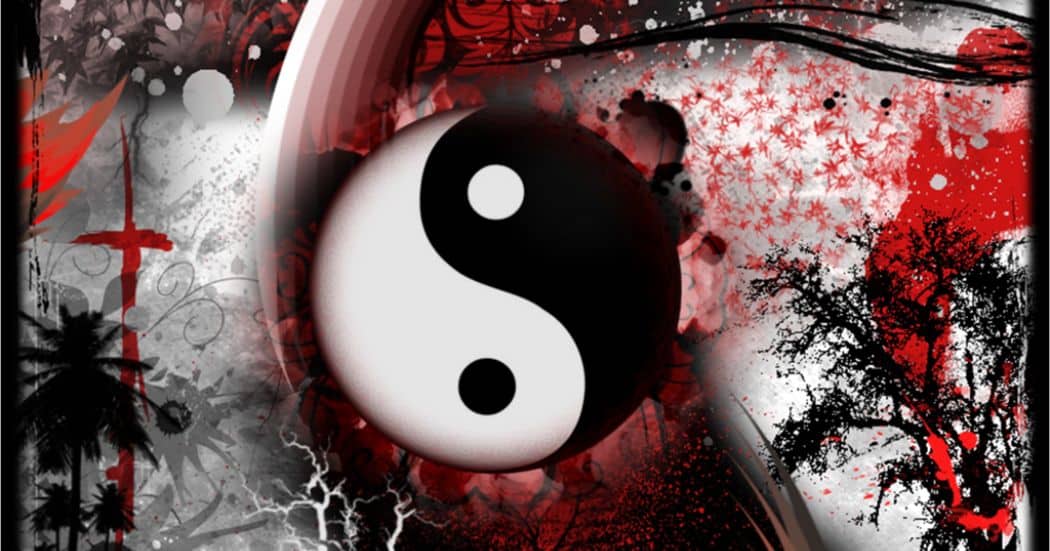
What does a yin yang necklace mean?
Origins and history of the yin yang symbol
The yin yang symbol, also known as the Taijitu, has a rich history and deep cultural significance. It originated in ancient China and is closely associated with Taoism, a philosophy that emphasizes living in harmony with the natural order of the universe. The symbol itself represents the interplay of opposing forces, with the black and white halves symbolizing the duality of existence.
The concept of yin and yang predates the symbol itself and can be traced back to ancient Chinese philosophy. Yin represents the feminine, passive, and dark aspects, while yang represents the masculine, active, and light aspects. The two halves of the symbol are intertwined, illustrating the harmonious balance between these opposing forces.
Throughout history, the yin yang symbol has been used in various contexts, including art, philosophy, and spirituality. It has become a universal symbol representing the interconnectedness of all things and the need for balance in life. Its timeless appeal has made it a popular choice for jewelry, including the iconic yin yang bracelet.
Meaning and symbolism of the yin yang necklace
Wearing a yin yang necklace can hold different meanings for different individuals. At its core, it serves as a reminder to seek balance and harmony in life. The contrasting black and white halves represent the constant interplay between opposing forces, reminding us of the need to embrace both light and darkness.
The yin yang necklace can also symbolize the harmony between feminine and masculine energies. It represents the complementary nature of these energies and encourages the wearer to embrace and integrate both aspects within themselves. This can be especially meaningful for individuals who seek to balance their own masculine and feminine traits.
Furthermore, the yin yang necklace can serve as a reminder of the universal interconnectedness of all things. It symbolizes the idea that everything in the universe is interconnected and interdependent. This can be a powerful reminder to live in harmony with the world around us and recognize the impact our actions have on others.
Cultural significance of the yin yang symbol
The yin yang symbol holds deep cultural significance in Chinese culture. It is often associated with Taoism, one of the major philosophical and religious traditions in China. Taoism teaches the importance of living in harmony with the natural order of the universe and embracing the balance between yin and yang.
In addition to its association with Taoism, the yin yang symbol has also been adopted by other cultures and belief systems around the world. It has become a universal symbol of balance, harmony, and interconnectedness. Its cultural significance extends beyond China and resonates with individuals from diverse backgrounds.
Different interpretations of the yin yang symbol
The yin yang symbol is open to various interpretations, and its meaning can vary depending on personal beliefs and cultural contexts. While the fundamental concept of balance and harmony remains consistent, individuals may attribute different meanings to the symbol based on their own experiences and philosophies.
For some, the yin yang symbol represents the balance between good and evil, emphasizing the need to find equilibrium between these opposing forces. It can serve as a reminder to strive for moral balance and make conscious choices that contribute to the greater good.
Others may interpret the yin yang symbol as a representation of the cyclical nature of life. It symbolizes the constant flow and interdependence of life’s dualities, such as birth and death, joy and sorrow, and growth and decay. It reminds us that change is inevitable and encourages acceptance of the natural ebb and flow of life.
Popular designs and styles of yin yang necklaces
Yin yang necklaces come in a wide variety of designs and styles, allowing individuals to find one that resonates with their personal tastes and preferences. From minimalist and understated designs to elaborate and ornate pieces, there is a yin yang necklace for everyone.
One popular design features a simple black and white yin yang pendant suspended from a delicate chain. This classic design is timeless and versatile, making it suitable for everyday wear. The contrasting colors of the pendant create a striking visual impact, drawing attention to the symbolic significance of the yin yang symbol.
For those who prefer a more unique and personalized touch, there are yin yang necklaces available with gemstone accents. These necklaces combine the inherent symbolism of the yin yang symbol with the healing properties and energy of gemstones. Each gemstone carries its own meaning and can enhance the overall symbolism of the necklace.
How to choose the right yin yang necklace
When choosing a yin yang necklace, there are several factors to consider to ensure it aligns with your personal style and preferences. First and foremost, consider the material of the necklace. Common options include sterling silver, gold, stainless steel, and leather. Each material has its own aesthetic appeal and durability, so choose one that suits your taste and lifestyle.
Next, think about the size and design of the yin yang pendant. Some individuals may prefer a larger and more prominent pendant, while others may prefer a smaller and more understated one. Consider the overall look you want to achieve and choose a pendant size that complements your style.
Additionally, pay attention to the chain length and style. A longer chain can create a more dramatic and layered look, while a shorter chain can be more delicate and subtle. Experiment with different chain lengths to find the one that suits your neckline and desired aesthetic.
How to wear and style a yin yang necklace
A yin yang necklace can be styled in various ways to suit different occasions and outfits. For a casual and everyday look, pair your necklace with a simple t-shirt or blouse. This will allow the necklace to take center stage and serve as a statement piece. Opt for a shorter chain length to keep the focus on the pendant.
For a more formal or dressy look, consider layering your yin yang necklace with other delicate necklaces. This creates a trendy and fashionable layered effect, adding depth and visual interest to your overall look. Mix and match different necklace lengths and styles to create a personalized and unique layered necklace design.
When it comes to styling a yin yang necklace, remember to consider the significance of the symbol. Wear it as a reminder to seek balance in your life and embrace the interconnectedness of all things. Allow the necklace to serve as a conversation starter and an opportunity to share the symbolism and meaning behind the yin yang symbol.
Where to buy authentic yin yang necklaces
Finding an authentic and high-quality yin yang necklace is essential to ensure its longevity and meaningfulness. There are several reputable sources where you can purchase authentic yin yang necklaces, both online and offline.
Online stores such as Chakra Galaxy offer a wide range of yin yang necklaces and yin yang bracelets Additionally, many jewelry stores and boutiques offer yin yang necklaces as part of their collections.
If you prefer a more personalized and unique piece, consider reaching out to local artisans and jewelry makers. They can create custom yin yang necklaces that cater to your specific preferences and requirements. This allows you to own a one-of-a-kind piece that holds special meaning to you.
-
 Vintage Alloy Triple Yin Yang Balance Necklace
Vintage Alloy Triple Yin Yang Balance Necklace -
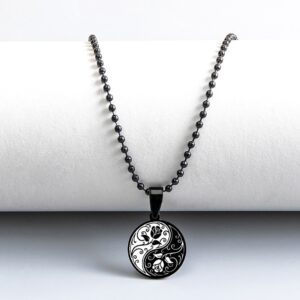 Rose & Yggdrasil Tree of Life Yin Yang Positive & Negative Necklace
Rose & Yggdrasil Tree of Life Yin Yang Positive & Negative Necklace -
 Taoist Monk Meditating Silver Alloy Yin Yang Necklace Pendant
Taoist Monk Meditating Silver Alloy Yin Yang Necklace Pendant -
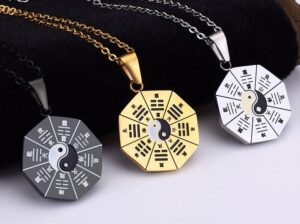 Yin Yang I Ching Hexagram Pendant Necklace (Gold, Silver, Black)
Yin Yang I Ching Hexagram Pendant Necklace (Gold, Silver, Black) -
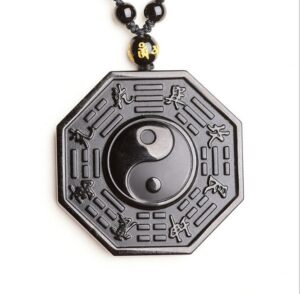 Obsidian Stone Bagua Chinese Elements Yin Yang Tai Chi Pendant Necklace
Obsidian Stone Bagua Chinese Elements Yin Yang Tai Chi Pendant Necklace -
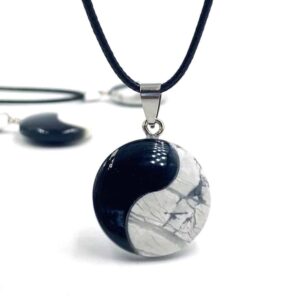 Black Agate And White Turquoise Reiki Healing Tai Chi Yin Yang Amulet
Black Agate And White Turquoise Reiki Healing Tai Chi Yin Yang Amulet -
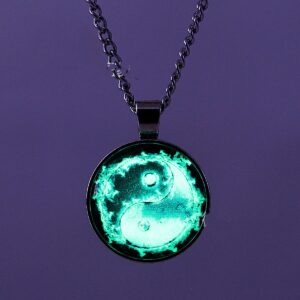 Unique Butterfly Elements Illuminated Yin Yang Symbol Necklace
Unique Butterfly Elements Illuminated Yin Yang Symbol Necklace -
 Golden Bagua Yin Yang Tai Chi Necklace Pendant
Golden Bagua Yin Yang Tai Chi Necklace Pendant -
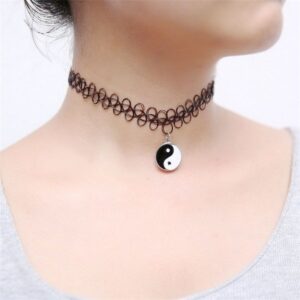 Unique Chinese Balance Symbol Yin Yang Women’s Choker Necklace
Unique Chinese Balance Symbol Yin Yang Women’s Choker Necklace
What are the benefits of wearing a yin yang pendant?
Balancing Energy and Promoting Harmony
One of the key benefits of wearing a yin yang pendant is its ability to balance energy and promote harmony in our lives. The yin yang symbol represents the perfect balance between opposing forces, reminding us to find equilibrium within ourselves and our surroundings. By wearing a yin yang pendant, we can tap into this harmonious energy and bring balance to our thoughts, emotions, and actions.
The yin yang pendant acts as a symbolic anchor, grounding us in the present moment and helping us stay centered amidst the chaos of daily life. It serves as a constant reminder to find harmony between work and play, rest and activity, solitude and socialization. By embracing the concept of yin yang, we create space for both light and darkness, allowing us to experience a more balanced and fulfilling life.
Enhancing Personal Growth and Spiritual Development
Wearing a yin yang pendant can also have profound effects on our personal growth and spiritual development. The symbol represents the journey of self-discovery and the quest for wholeness. By wearing it, we invite introspection and self-awareness, encouraging us to explore our inner selves and uncover hidden aspects of our personality.
The yin yang pendant serves as a beacon, guiding us towards personal transformation and spiritual enlightenment. It encourages us to embrace both our strengths and weaknesses, as well as our light and shadow selves. By integrating these contrasting elements, we can achieve a greater sense of self-acceptance and self-compassion.
Promoting Physical and Emotional Well-being
In addition to its spiritual benefits, wearing a yin yang pendant can also contribute to our physical and emotional well-being. The symbol represents the harmonious flow of energy, known as qi or chi, within our bodies. When this energy is balanced and unobstructed, we experience optimal health and vitality.
The yin yang pendant acts as a catalyst for the free flow of energy, promoting physical healing and emotional well-being. It helps to restore balance to our body’s energy centers, known as chakras, allowing for the smooth circulation of vital life force energy. This can result in improved overall health, increased energy levels, and a greater sense of vitality.
Attracting Positive Energy and Protection
Another advantage of wearing a yin yang pendant is its ability to attract positive energy and provide protection against negative influences. The symbol is believed to act as a shield, warding off negative energies and promoting a sense of security and protection.
By wearing a yin yang pendant, we create a sacred space within ourselves, inviting positive energy and repelling negative vibrations. It serves as a reminder to stay grounded and centered, even in challenging situations. The yin yang pendant can act as a talisman, offering a sense of comfort and reassurance during times of stress or uncertainty.
How to Choose the Right Yin Yang Pendant
When choosing a yin yang pendant, it is important to consider both the design and the materials used. The design should resonate with your personal style and taste, as well as reflect the meaning and symbolism of yin yang. There are various styles available, ranging from simple and minimalist to intricate and ornate.
In terms of materials, yin yang pendants can be crafted from a wide range of materials, including precious metals like gold and silver, as well as gemstones, crystals, and even wood. Each material carries its own unique energy and properties, so it is important to choose one that aligns with your intentions and preferences.
Different Styles and Materials of Yin Yang Pendants
Yin yang pendants come in a variety of styles and materials, allowing you to find the perfect piece that resonates with you. Here are some popular styles and materials to consider:
- Minimalist: If you prefer a clean and simple design, a minimalist yin yang pendant may be the perfect choice. These pendants feature a sleek and understated design, often made from stainless steel or sterling silver. They are versatile and can be worn with any outfit, making them a timeless addition to your jewelry collection.
- Artistic: For those who appreciate fine craftsmanship and intricate details, an artistic yin yang pendant may be the way to go. These pendants are often handcrafted by skilled artisans, featuring elaborate engravings or embellishments. They can be made from various materials, such as gold, silver, or even enamel.
- Gemstone: If you are drawn to the healing properties of crystals and gemstones, a yin yang pendant featuring these materials can offer added benefits. Each gemstone carries its own unique energy and properties, which can enhance the overall meaning and symbolism of the pendant. Popular gemstones include amethyst, rose quartz, and lapis lazuli.
- Wood: For a more natural and earthy feel, consider a yin yang pendant made from wood. Wood is a grounding material that can help you connect with nature and foster a sense of peace and tranquility. These pendants are often hand-carved and can feature intricate designs or inlays.
When choosing a yin yang pendant, trust your intuition and select the one that resonates with you on a deeper level. Remember, it is not just a piece of jewelry but a powerful symbol that holds personal meaning and significance.
-
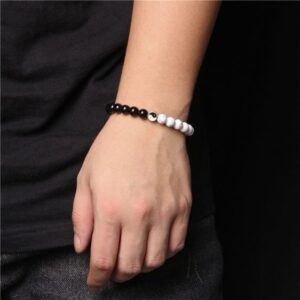 White Howlite And Black Onyx Yin-Yang Balance Energy Bracelet
White Howlite And Black Onyx Yin-Yang Balance Energy Bracelet -
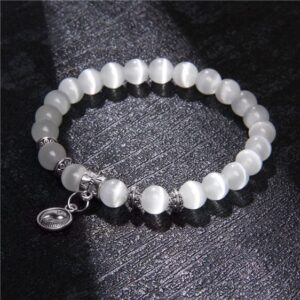 8mm White Cat’s Eye Stone With Yin-Yang Pendant Charm Bracelet
8mm White Cat’s Eye Stone With Yin-Yang Pendant Charm Bracelet -
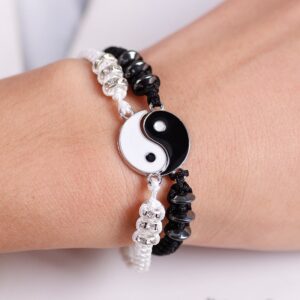 Yin Yang Braided Rope Bracelet for Couples
Yin Yang Braided Rope Bracelet for Couples -
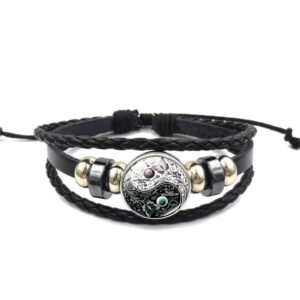 Tai Chi Yin Yang Braided Bracelet for Men
Tai Chi Yin Yang Braided Bracelet for Men -
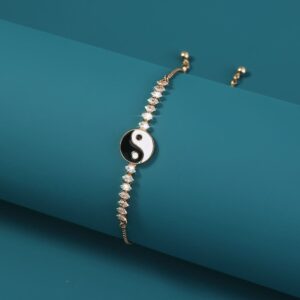 Brass Gold Plated Micro-Set Zircon Yin Yang Bracelet
Brass Gold Plated Micro-Set Zircon Yin Yang Bracelet -
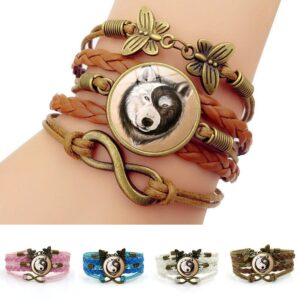 Vintage Wolf Face Leather Yin Yang Bracelet
Vintage Wolf Face Leather Yin Yang Bracelet -
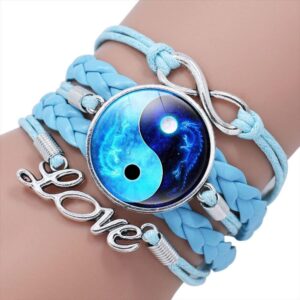 White Blue Yin Yang Braided Bracelet for Women
White Blue Yin Yang Braided Bracelet for Women -
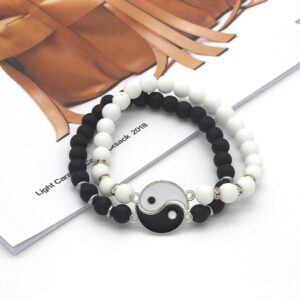 Black White Natural Stone Yin Yang Bracelet for Couples
Black White Natural Stone Yin Yang Bracelet for Couples -
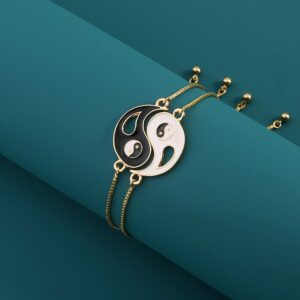 Yin Yang Golden Bracelet for Couples & Lovers
Yin Yang Golden Bracelet for Couples & Lovers
What is the meaning of yin and yang?
Origins and history of yin and yang
The concept of yin and yang has a long and rich history dating back thousands of years in ancient Chinese philosophy. The origins of yin and yang can be traced back to the ancient Chinese text known as the “Yijing” or “Book of Changes.” This text, which is considered one of the oldest Chinese classics, contains the foundational principles of yin and yang.
In the “Yijing,” yin and yang are described as two opposing forces that are interdependent and interconnected. These forces are seen as the fundamental building blocks of the universe, representing the dualities and harmonies that exist in all aspects of life. The concept of yin and yang expanded beyond philosophy and became a way of understanding the world and organizing knowledge.
Symbolism and representation of yin and yang
Yin and yang are often associated with a range of symbolic representations that further enhance their meaning. The yin and yang symbol is perhaps the most recognizable representation, with its distinctive swirling shapes. The circular shape of the symbol represents the eternity and cyclical nature of life, while the contrasting colors emphasize the duality and interdependence of yin and yang.
In addition to the Taijitu, yin and yang can also be represented by various other symbols, such as the dragon and the phoenix. The dragon, with its dynamic and masculine qualities, represents yang, while the phoenix, with its nurturing and feminine qualities, represents yin. These symbols illustrate the different aspects and energies associated with yin and yang and their interconnectedness in the natural world.
Yin and yang in Eastern philosophy and religion
The concepts of yin and yang extend beyond Chinese philosophy and have influenced various Eastern philosophies and religions. In Taoism, yin and yang are fundamental principles that guide the understanding of the world and the cultivation of harmony within oneself. Taoist philosophy emphasizes the importance of embracing both yin and yang energies to achieve balance and inner peace.
In Buddhism, yin and yang are embodied in the concept of interdependent origination, which states that all phenomena arise and exist in dependence on multiple causes and conditions. This concept highlights the interconnectedness of all things and the dynamic balance between opposing forces. Yin and yang are also present in other Eastern philosophies, such as Confucianism and Zen Buddhism, adding depth and nuance to their teachings.
Yin and yang in traditional Chinese medicine
Yin and yang are integral to traditional Chinese medicine (TCM), an ancient system of healthcare that aims to restore and maintain balance in the body. In TCM, the body is seen as a microcosm of the universe, and health is believed to be the result of the harmonious interaction between yin and yang energies.
According to TCM, illness occurs when there is an imbalance or disruption in the flow of yin and yang. Practitioners of TCM use various techniques, such as acupuncture, herbal medicine, and dietary therapy, to restore balance and promote the body’s natural healing abilities. By understanding the principles of yin and yang, TCM offers a holistic approach to health and well-being.
Yin and yang in feng shui
Feng shui, the ancient Chinese art of placement, also incorporates the principles of yin and yang. In feng shui, the goal is to create a harmonious and balanced environment that supports the well-being and prosperity of its inhabitants. This is achieved by arranging and organizing the physical space in a way that maximizes the flow of positive energy, known as “qi.”
Yin and yang play a crucial role in feng shui, as they represent different qualities and energies that need to be balanced within a space. For example, a bedroom, which is associated with rest and relaxation, should have a more yin energy, while a living room, where social interactions take place, should have a more yang energy. By considering the yin and yang aspects of a space, feng shui aims to create a harmonious and supportive environment.
Applying the concept of yin and yang in daily life
The concept of yin and yang is not limited to ancient philosophy, medicine, and feng shui. It can also be applied to our daily lives to enhance our well-being and relationships. By understanding the dynamic interplay between yin and yang, we can strive for balance and harmony in different aspects of our lives.
In terms of health, balancing yin and yang energies can help us maintain physical, mental, and emotional well-being. This can involve incorporating activities that promote relaxation and restoration, such as meditation and yoga (yin), as well as engaging in activities that promote strength and vitality, such as exercise and social interactions (yang).
In relationships, understanding yin and yang can help us navigate the dynamics between individuals. It reminds us of the importance of balancing giving and receiving, listening and expressing, and nurturing and asserting. By recognizing and honoring the complementarity of yin and yang energies, we can cultivate healthier and more fulfilling relationships.
Yin and yang in popular culture
The concept of yin and yang has also made its way into popular culture, often in the form of symbols, artwork, and tattoos. Many people are drawn to the visual appeal of the yin and yang symbol and the deeper meanings it represents. It has become a popular choice for those seeking to express their belief in balance and harmony.
Additionally, yin and yang can be found in various forms of media, such as movies, literature, and music. The concept is often used metaphorically to explore themes of duality, balance, and personal growth. From the iconic light and dark sides of “Star Wars” to the contrasting personalities of fictional characters, yin and yang continue to captivate and inspire audiences.
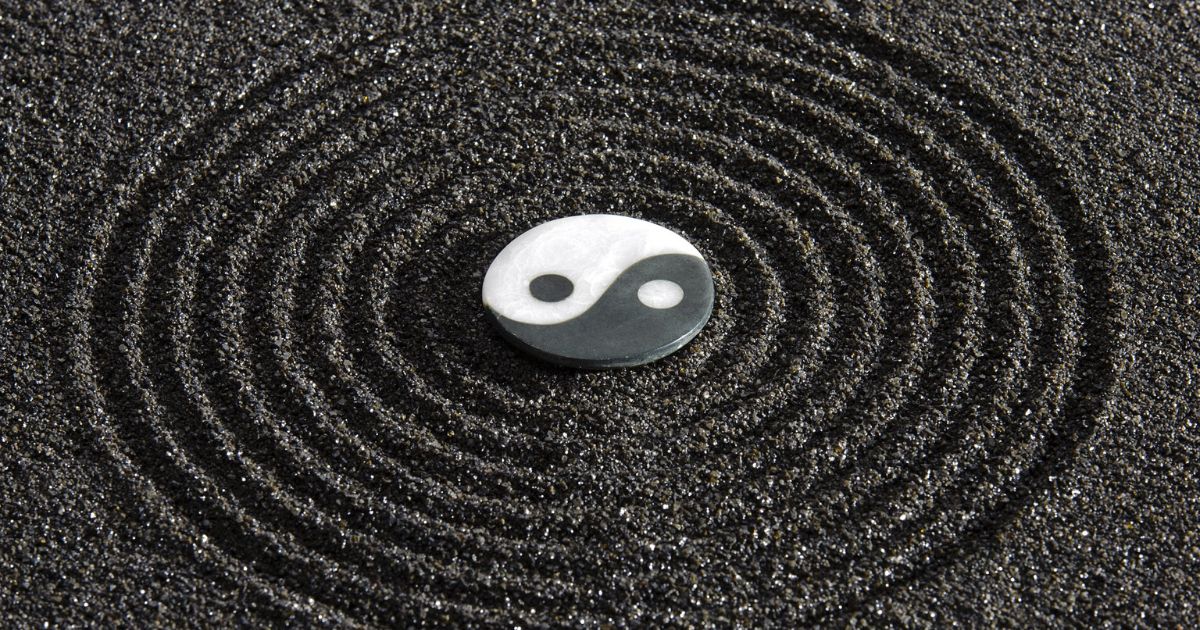
Does Yin Yang mean balance?
The concept of balance in yin and yang
At the heart of the yin and yang philosophy is the idea of balance. Yin and yang are not static or fixed entities but are constantly in flux, interacting with and influencing each other. They are like two sides of the same coin, each containing a seed of the other within itself. This dynamic interplay between yin and yang is believed to be essential for maintaining harmony and equilibrium in the universe.
In the yin and yang symbol, known as the Taijitu, the white half represents yang, while the black half represents yin. However, the symbol also contains a small dot of the opposite color within each half, symbolizing the presence of yin within yang and vice versa. This symbol visually represents the concept of balance and the interconnectedness of opposing forces.
Yin and Yang as a symbol of balance
While Yin Yang represents more than just balance, it is often used as a symbol to represent the harmonious interplay of opposing forces. The Yin Yang symbol, also known as the Taijitu, consists of a circle divided into two halves – one black (Yin) and one white (Yang). Within each half, there is a smaller circle of the opposite color, symbolizing the presence of Yin within Yang and vice versa.
The symbol represents the idea that nothing is purely Yin or Yang, but rather a combination of both. It serves as a reminder that balance and harmony can only be achieved by embracing both aspects and recognizing their interdependence.
Yin and Yang in nature
The concept of Yin Yang can be observed in the natural world. Day and night, hot and cold, summer and winter – these are all examples of opposing forces that exist in a state of dynamic balance. Just as Yin and Yang are in constant flux, the natural world undergoes continuous cycles of growth, decay, and renewal.
For example, the changing seasons reflect the interplay between Yin and Yang. Winter represents the Yin aspect with its cold and darkness, while summer represents the Yang aspect with its warmth and light. Each season has its own unique qualities, yet they are all interconnected and necessary for the overall balance and harmony of the ecosystem.
Yin and Yang in human psychology
The concept of Yin Yang also extends to human psychology. It is believed that each individual possesses both Yin and Yang qualities within themselves. Yin qualities include introspection, receptiveness, and nurturing, while Yang qualities include assertiveness, action, and ambition.
A healthy psychological state involves maintaining a balance between these opposing qualities. Too much Yin can lead to passivity and stagnation, while too much Yang can result in aggression and burnout. Achieving balance requires self-awareness and the ability to adapt to changing circumstances.
Achieving balance through Yin Yang
Understanding the true meaning of Yin Yang can provide insights into how we approach life and navigate its ups and downs. It teaches us that balance is not a destination to be reached but rather a continuous process of harmonizing opposing forces.
To achieve balance, it is important to embrace change and adaptability. Just as Yin and Yang transform into one another, we must be willing to let go of rigid expectations and embrace the fluidity of life. This means being open to new experiences, seeking harmony in relationships, and finding ways to integrate both Yin and Yang qualities in our daily lives.
Misconceptions about Yin Yang
There are several misconceptions about Yin Yang that can cloud our understanding of its true meaning. One common misconception is that Yin represents negativity and Yang represents positivity. In reality, Yin and Yang are both necessary and complementary aspects of existence, and neither is inherently good or bad.
Another misconception is that Yin and Yang are static opposites. In truth, Yin and Yang are in constant motion, constantly transforming and influencing one another. The balance between Yin and Yang is not a fixed state but rather a dynamic process.
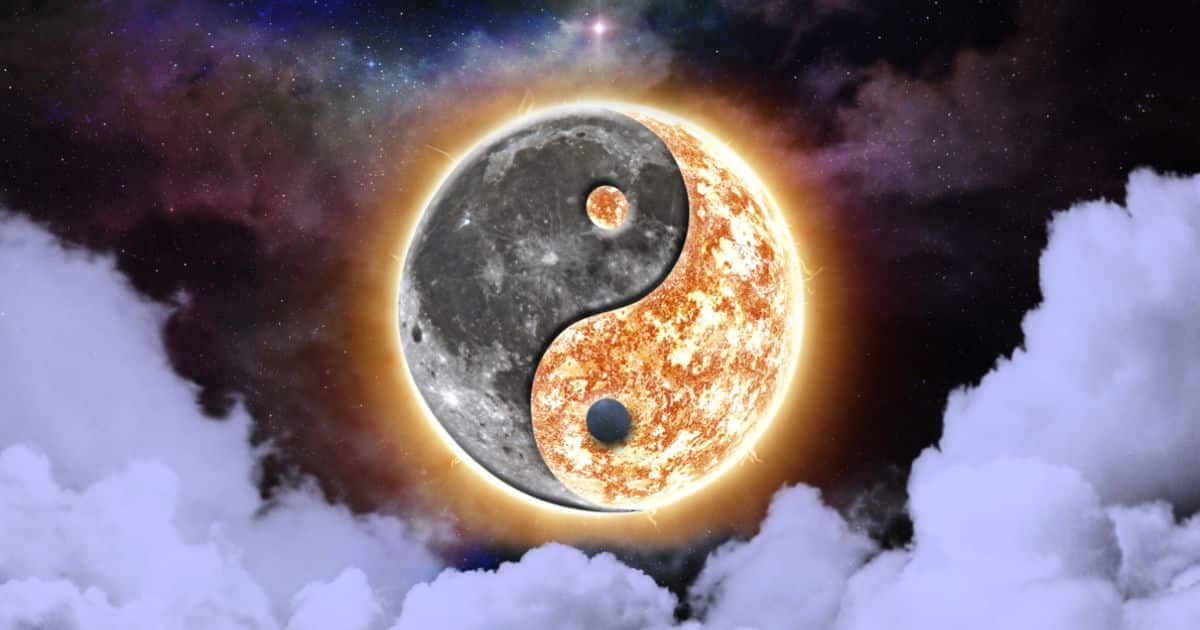
What does yin and yang mean in love?
In love, the concept of yin and yang goes beyond its traditional association with balance and harmony. Understanding what yin and yang means in the context of love can shed light on the dynamics of relationships and help people navigate their romantic journey with greater awareness.
The ancient Chinese philosophy of yin and yang teaches us that love is a delicate dance between feminine and masculine energies. Yin represents the receptive and nurturing qualities, while yang embodies the assertive and active attributes. When these energies are in balance, relationships thrive. However, an imbalance can result in conflict and dissatisfaction.
By delving into the concept of yin and yang in love, individuals can deepen their understanding of themselves and their partners, fostering healthier and more fulfilling connections.
Yin and yang in relationships
When yin and yang energies are in balance within a relationship, it creates a harmonious union where each partner feels seen, heard, and understood. Yin qualities, such as empathy, compassion, and receptivity, allow for emotional connection and nurturing within the relationship. Yang qualities, such as assertiveness, leadership, and action, bring passion, drive, and stability.
In a balanced relationship, yin and yang energies flow and interact, enhancing the overall connection between partners. Yin qualities soften the edges of yang, creating a safe space for vulnerability and emotional intimacy. Yang qualities provide a sense of security and protectiveness, allowing the relationship to flourish.
Understanding the balance of yin and yang in love
To understand the balance of yin and yang in love, it is essential to recognize that each individual possesses a unique blend of yin and yang qualities. Some individuals may naturally exhibit more yin qualities, while others may lean towards yang qualities. However, it is crucial to embrace and integrate both energies within oneself and the relationship.
Finding balance involves acknowledging and valuing the strengths and contributions of both yin and yang energies. It requires open communication, mutual respect, and a willingness to embrace the full spectrum of each other’s qualities. By recognizing and appreciating the inherent differences in yin and yang energies, couples can create a supportive and nurturing environment for love to flourish.
Signs of imbalance in yin and yang in relationships
When there is an imbalance in yin and yang energies within a relationship, it can lead to disharmony and dissatisfaction. Some signs of imbalance include:
- Emotional disconnection: When one partner consistently dominates the relationship, it can lead to a lack of emotional connection and understanding.
- Power struggles: Imbalances in yang energies can result in power struggles, with one partner trying to exert control and dominance over the other.
- Lack of nurturing: If there is an imbalance towards yang energies, the nurturing and supportive aspects of the relationship may be neglected, leading to feelings of neglect or emotional distance.
- Lack of assertiveness: On the other hand, an imbalance towards yin energies may result in a lack of assertiveness and boundaries, leading to feelings of being taken for granted or not heard.
How to maintain balance in yin and yang in love
Maintaining balance in yin and yang energies is an ongoing process that requires conscious effort and self-awareness. Here are some strategies to help cultivate and sustain balance in a relationship:
- Communication: Open and honest communication is key to understanding each other’s needs and desires. Creating a safe space for dialogue allows for the expression of both yin and yang energies, fostering mutual understanding and growth.
- Self-reflection: Regular self-reflection helps individuals identify their own dominant energies and recognize areas where they may need to cultivate balance. Taking time to assess one’s own needs and desires can contribute to the overall balance of yin and yang in the relationship.
- Mutual support: Supporting each other’s growth and development is essential in maintaining balance. Encouraging and celebrating each other’s strengths and achievements promotes a harmonious union of yin and yang energies.
- Embracing polarity: Embracing the natural polarity of yin and yang energies can enhance the passion and attraction within a relationship. Embracing and celebrating the differences between partners can create a magnetic and fulfilling connection.
Applying yin and yang principles in daily life
The principles of yin and yang can extend beyond romantic relationships and be applied to various aspects of daily life. By embracing these principles, individuals can cultivate balance and harmony in all areas of their lives.
- Self-care: Balancing yin and yang energies begins with self-care. Nurturing oneself through activities such as meditation, mindfulness, and self-reflection helps maintain inner harmony and promotes a healthy balance of energies.
- Work-life balance: Applying the principles of yin and yang in the workplace involves finding a balance between assertiveness and receptivity. Balancing hard work and ambition with rest and relaxation promotes overall well-being and prevents burnout.
- Social interactions: Understanding the interplay of yin and yang energies can enhance social interactions. Being receptive and empathetic while also asserting boundaries and expressing oneself authentically creates healthier and more fulfilling connections with others.
Benefits of embracing yin and yang in love
Embracing yin and yang energies in love offers numerous benefits for individuals and relationships. Some of the benefits include:
- Greater understanding: Understanding the interplay of yin and yang energies allows for a deeper understanding of oneself and one’s partner, fostering empathy and compassion.
- Enhanced communication: Balancing yin and yang energies promotes open communication, allowing for honest and authentic expression of needs and desires.
- Emotional intimacy: By creating a safe space for vulnerability and emotional connection, yin and yang energies foster deeper emotional intimacy in relationships.
- Harmonious union: When yin and yang energies are in balance, relationships thrive, resulting in a harmonious and fulfilling union.
Misconceptions about yin and yang in love
There are several misconceptions surrounding the concept of yin and yang in love. It is important to address these misconceptions to gain a more accurate understanding of the concept.
- Gender roles: Yin and yang energies in love are not limited to traditional gender roles. Both men and women possess a unique blend of yin and yang energies, regardless of societal expectations.
- Fixed attributes: Yin and yang energies are not fixed attributes but exist on a spectrum. Each individual possesses a unique balance of yin and yang energies that can shift and evolve over time.
- Imbalance as failure: Imbalances in yin and yang energies are not indicative of failure in a relationship. Recognizing and addressing imbalances is an opportunity for growth and deepening the connection between partners.
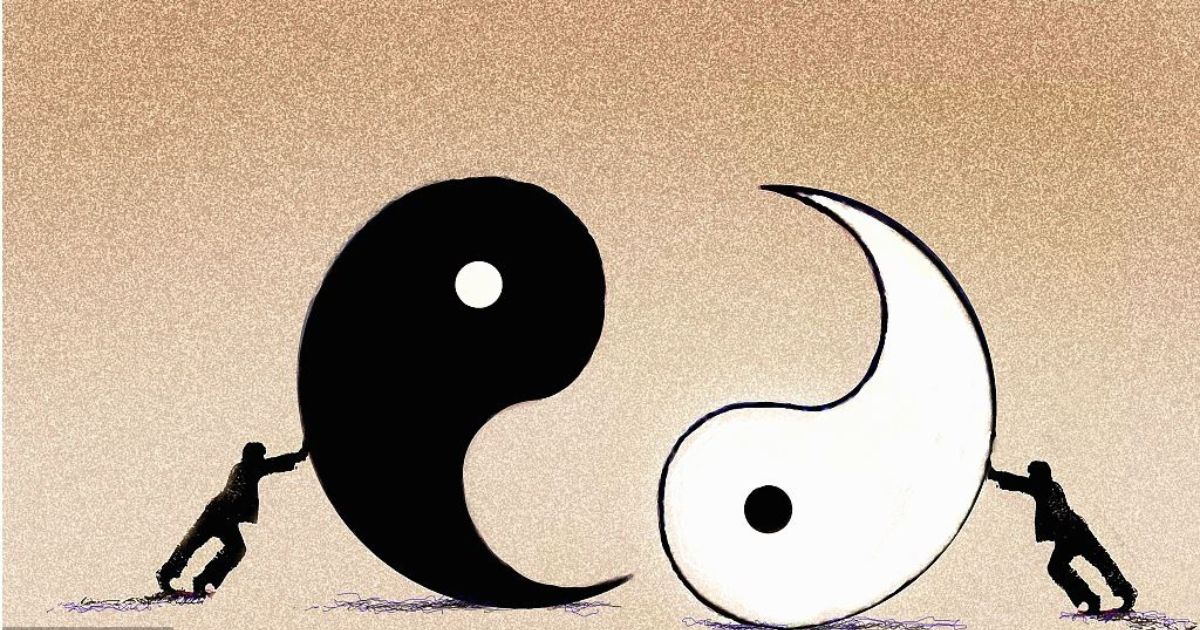
Do yin and yang attract each other?
In the realm of philosophy and Chinese culture, the concept of yin and yang has always been a topic of fascination. These opposing forces are believed to be interconnected and balanced, constantly attracting and complementing each other. But do yin and yang truly attract each other, or is it just a symbolic representation?
The Theory Behind Yin and Yang Attraction
But what exactly causes this attraction? Is it a magnetic force, a metaphorical bond, or something else entirely? Ancient Chinese texts provide insights into the theory behind yin and yang attraction. According to these texts, the attraction between yin and yang is rooted in the principle of harmony and balance. Just as day turns into night and summer transitions into winter, yin and yang are in a perpetual dance of attraction and repulsion.
This attraction is not limited to a physical or tangible force but extends to the philosophical and spiritual realms as well. The balance between yin and yang is believed to be the foundation of all existence, with their attraction serving as a catalyst for growth and transformation. It is through this interplay that life finds its rhythm, and the universe maintains its equilibrium.
Examples of Yin and Yang Attraction in Nature
To better understand the concept of yin and yang attraction, we can observe its manifestations in nature. From the ebb and flow of ocean tides to the cycle of seasons, the natural world is filled with examples of yin and yang in constant attraction. The interplay between day and night, hot and cold, and expansion and contraction all demonstrate the inherent balance and attraction between opposing forces.
Take, for instance, the relationship between plants and pollinators. Flowers, with their vibrant colors and sweet fragrances, attract bees and butterflies, which in turn aid in the fertilization and reproduction of plants. This symbiotic relationship relies on the attraction between yin and yang, as the flowers and pollinators complement and rely on each other for survival and propagation.
Yin and Yang Attraction in Relationships
The concept of yin and yang attraction extends beyond the natural world and into the realm of human relationships. In interpersonal connections, the attraction between yin and yang can be observed in the dynamics between individuals with contrasting qualities. Just as yin represents the feminine and yang represents the masculine, the attraction between individuals with complementary traits creates a harmonious balance.
In romantic relationships, for example, partners often exhibit a balance of yin and yang qualities. One partner may possess more nurturing and receptive yin qualities, while the other embodies assertive and active yang traits. This attraction between opposites creates a sense of completeness and harmony within the relationship.
The Role of Yin and Yang Attraction in Personal Growth
Yin and yang attraction not only influences our relationships but also plays a crucial role in personal growth and self-discovery. Just as yin and yang are interdependent and interconnected, our own journey of self-discovery involves embracing both our yin and yang aspects. By acknowledging and integrating our strengths and weaknesses, we can achieve a sense of wholeness and balance.
Embracing the attraction between yin and yang within ourselves allows for personal growth and transformation. It is through this interplay that we can cultivate qualities such as compassion and resilience, assertiveness and receptiveness, and creativity and logic. By harnessing the power of yin and yang attraction, we can unlock our full potential and navigate life’s challenges with grace.
Yin and Yang Attraction in the Workplace
The concept of yin and yang attraction also finds relevance in the realm of the workplace. In a professional setting, diverse teams that encompass a balance of yin and yang qualities often thrive. The attraction between individuals with different skill sets and perspectives fosters innovation, collaboration, and creative problem-solving.
For example, a team composed of individuals with analytical and logical yang qualities can benefit from the addition of team members with intuitive and creative yin traits. This interplay between yin and yang sparks new ideas, encourages outside-the-box thinking, and enhances overall team performance.
Yin and Yang Attraction in Health and Wellness
In the realm of health and wellness, the concept of yin and yang attraction is closely tied to the balance of energies within the body. Traditional Chinese medicine recognizes the importance of maintaining a harmonious flow of yin and yang energies to promote physical and emotional well-being.
According to this ancient practice, an imbalance in yin and yang energies can lead to various health issues. By cultivating the attraction between yin and yang energies through practices such as acupuncture, herbal medicine, and tai chi, individuals can restore balance and promote overall health and vitality.
Balancing Yin and Yang Energies
Achieving a harmonious balance of yin and yang energies is essential for overall well-being. Balancing these energies involves recognizing when one aspect dominates and consciously cultivating the opposite to restore equilibrium.
Practices such as meditation, yoga, and mindfulness can help individuals attune to their yin and yang energies and find a state of balance. By embracing both the receptive and active qualities within ourselves, we can lead more fulfilling and harmonious lives.
Cultivating Yin and Yang Attraction in Daily Life
To harness the power of yin and yang attraction in our daily lives, it is important to cultivate awareness and intentionality. By paying attention to the interplay of opposing forces within ourselves and the world around us, we can navigate life’s challenges with greater ease and grace.
Embracing the attraction between yin and yang involves seeking out experiences and relationships that complement and balance our own energies. It requires embracing both light and dark, action and rest, and strength and vulnerability. By consciously cultivating yin and yang attraction, we can live in alignment with the natural flow of life.
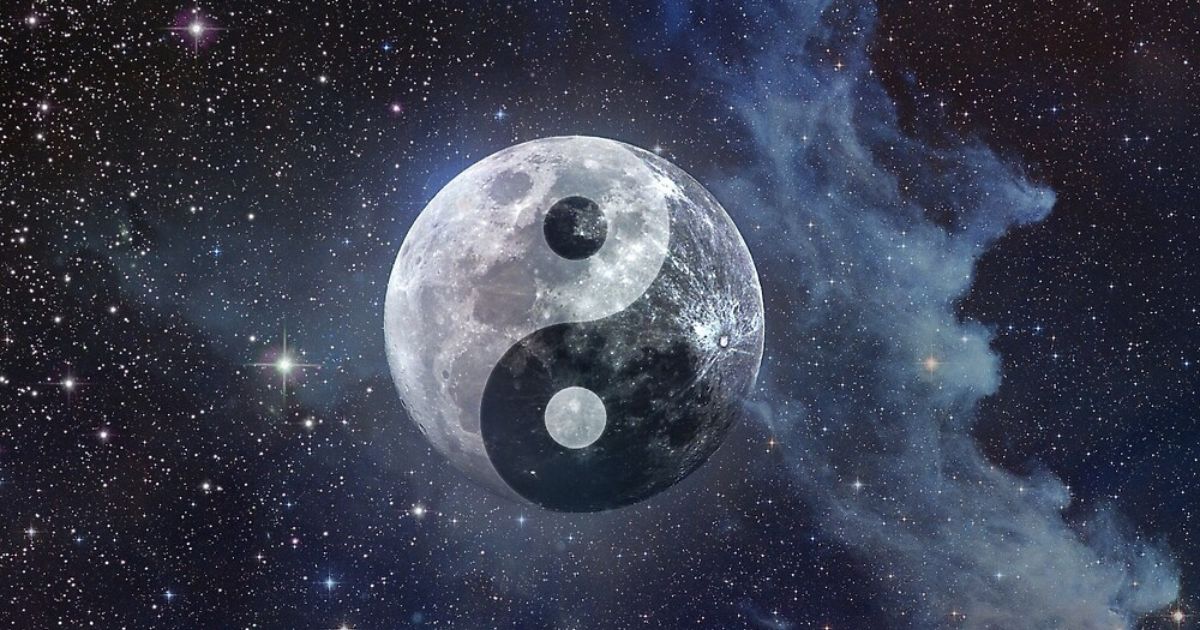
Is Yin Yang Chinese or Japanese?
While the Yin Yang symbol has permeated multiple cultures, it is rooted in ancient Chinese philosophy. Its universal appeal lies in its timeless message of balance and harmony. Whether it is used in Chinese culture to represent the interplay of opposing forces or in Japanese culture to symbolize the interconnectedness of all things, Yin Yang serves as a reminder of the need to embrace both light and dark, active and passive, in order to achieve balance in life.
The Origins of Yin Yang
The concept of Yin Yang originates from ancient Chinese philosophy and is deeply ingrained in Chinese culture. The principles of Yin and Yang can be traced back to the earliest Chinese philosophical texts, such as the I Ching or Book of Changes, which date back over 3,000 years. These texts explore the duality and interconnectedness of opposing forces in the universe.
However, it is important to note that the Yin Yang symbol itself did not develop until later. Its creation is often attributed to the Chinese philosopher and scholar, Zou Yan, during the Warring States period. Zou Yan’s teachings on the Five Elements theory and the interplay of Yin and Yang greatly influenced the development of the symbol.
Yin Yang in Chinese Culture
The Yin Yang symbol holds great significance in Chinese culture. It is seen as a representation of the natural balance and harmony that exists in the universe. The concept of Yin Yang is applied to various aspects of Chinese life, including medicine, astrology, and even architecture.
In Chinese philosophy, Yin represents the feminine, passive, and dark aspects, while Yang represents the masculine, active, and light aspects. The symbol itself reflects the dynamic relationship between these opposing forces, with the black half representing Yin and the white half representing Yang. The small dots within each half symbolize the presence of the opposite force within each element.
Yin Yang in Japanese Culture
While the Yin Yang symbol is closely associated with Chinese culture, it has also been adopted and adapted by various other cultures, including Japanese Buddhism. This has led to some confusion regarding its origins. However, it is essential to recognize that the fundamental concept of Yin Yang originated in China.
In Japan, the Yin Yang symbol is known as the “In-yo” symbol. It is used to represent the same principles of balance and harmony as in Chinese culture. However, the Japanese interpretation of Yin and Yang is slightly different from the Chinese perspective.
Differences between Chinese and Japanese Interpretations of Yin Yang
In Chinese culture, Yin and Yang are seen as opposing but complementary forces that are constantly in flux. They are not seen as good or evil, but rather as natural and necessary aspects of the universe. Yin Yang represents the ever-changing balance between light and dark, hot and cold, and other opposing forces.
In Japanese culture, the interpretation of Yin and Yang is influenced by the concepts of Buddhism and Shintoism. The In-yo symbol is often associated with the Buddhist concept of “engi,” which refers to the interconnectedness and interdependence of all things. In Japanese culture, Yin and Yang are seen as complementary forces that work together to create harmony.
Similarities between Chinese and Japanese Interpretations of Yin Yang
Despite the differences in interpretation, there are also similarities between the Chinese and Japanese views of Yin Yang. Both cultures recognize the importance of balance and harmony in the natural world. They both believe that the interplay of opposing forces is necessary for the proper functioning of the universe.
In both Chinese and Japanese culture, Yin and Yang are seen as complementary and interconnected forces. They are not static or absolute, but rather fluid and constantly changing. The Yin Yang symbol serves as a reminder of the need to embrace both light and dark, active and passive, in order to achieve balance and harmony.
Yin Yang in Japanese Martial Arts
In Japanese martial arts, the concept of Yin and Yang is applied to the practice of combat. The idea is to achieve a balance between soft and hard, passive and active, in order to be an effective martial artist. This is seen in martial arts such as Aikido, which emphasizes blending with and redirecting the opponent’s energy.
The principles of Yin and Yang are also evident in the philosophy of Bushido, the way of the warrior. Bushido emphasizes the importance of balance, discipline, and honor in the practice of martial arts. The concept of Yin and Yang is seen as a guiding principle in the pursuit of mastery and self-improvement.
The Influence of Yin Yang in Modern Chinese and Japanese Society
The Yin Yang symbol continues to have a significant impact on modern Chinese and Japanese society. In China, the symbol is often used in branding and design to convey a sense of balance and harmony. It is also incorporated into traditional Chinese art and architecture as a symbol of cultural identity.
In Japan, the In-yo symbol is often used in popular culture and media. It is seen in anime, manga, and video games, where it is used to represent the dynamic interplay of opposing forces. The symbol is also used in contemporary Japanese art and design as a symbol of balance and harmony. Moreover, contemporary digital artists adept at editing video often integrate the In-yo symbol seamlessly into their visual narratives, leveraging its profound cultural significance to imbue their creations with a sense of dynamic equilibrium and thematic depth.

What religion is yin yang?
Relationship between yin and yang and Taoism
In Taoism, yin and yang are seen as fundamental aspects of the Tao, the underlying principle of the universe. The Tao is often described as the way or the path, representing the natural flow and rhythm of life. Yin and yang are the manifestations of this cosmic energy, representing the dualistic nature of existence.
Taoism teaches that by living in harmony with the Tao and embracing the principles of yin and yang, individuals can achieve a state of balance and alignment with the natural order of things. This involves recognizing the cyclical nature of life, accepting the constant change and transformation, and seeking harmony in all aspects of life.
Taoist practices such as meditation, qigong, and tai chi aim to cultivate and balance the yin and yang energies within the body and mind. By doing so, practitioners seek to harmonize their energy, promote physical and emotional well-being, and align themselves with the flow of the universe.
Yin and yang in other religions and belief systems
Although yin and yang are closely associated with Taoism, their symbolism and concepts can also be found in other religious and philosophical traditions. One such tradition is Buddhism, which originated in ancient India but has had a significant influence on Chinese culture and thought.
In Buddhism, the concept of yin and yang is often referred to as the interplay of complementary forces. It is seen as a way to understand the interconnectedness and interdependence of all things. Buddhism teaches that everything in the universe is subject to change, and there is a constant flux between opposing forces, similar to the concept of yin and yang.
Confucianism, another major philosophy in China, also incorporates the concept of yin and yang. Confucianism emphasizes the importance of harmony, balance, and social order. The concept of yin and yang helps to explain the harmony between opposing forces and the need for balance in all aspects of life, including relationships and societal structures.
Different interpretations of yin and yang across cultures
While yin and yang originated in Chinese philosophy, their concepts have transcended cultural boundaries and have been interpreted and adapted by various cultures around the world. In each culture, yin and yang may be understood and applied differently, reflecting the unique beliefs and values of that society.
In traditional Chinese medicine, yin and yang are used to understand the balance of energies within the body and diagnose and treat various ailments. The concept of yin and yang is also found in feng shui, the ancient Chinese practice of arranging space to create harmonious environments.
In Western cultures, yin and yang have often been simplified and associated with concepts such as good and evil, light and dark, or male and female. While these associations capture certain aspects of yin and yang, they fail to encompass the full complexity and depth of the concept as understood in Chinese philosophy.
How yin and yang are applied in daily life and personal growth
The principles of yin and yang can be applied in various aspects of life to cultivate balance, harmony, and personal growth. Understanding and embracing the concepts of yin and yang can help individuals navigate the complexities of life and find equilibrium in the face of challenges.
In relationships, the concept of yin and yang can be applied to understand the complementary nature of masculine and feminine energies. It reminds us that balance and harmony can be achieved by embracing and appreciating the differences between individuals.
In personal growth and self-development, yin and yang can be seen as a reminder to embrace both our light and dark aspects. It encourages us to acknowledge and accept our strengths and weaknesses, our successes and failures, and to find balance between action and rest, introspection and expression.
Yin and yang in popular culture and modern society
The yin yang symbol has become a popular motif in popular culture and is often used as a decorative element. It has been incorporated into various forms of art, fashion, and design, and has become a recognizable symbol of balance and harmony.
In modern society, the principles of yin and yang continue to be relevant. As individuals navigate the complexities of the modern world, the concept of yin and yang can serve as a reminder to find balance, embrace change, and seek harmony in all aspects of life.
Final Words
As we conclude our exploration of the meaning and benefits of Yin Yang necklaces, one question lingers in the air: Are we truly in tune with the delicate equilibrium of our existence? In a world that often seems divided and polarized, these timeless symbols serve as a powerful reminder of the interconnectedness and unity that underlies all aspects of life.
Beyond their fashionable allure, Yin Yang necklaces offer wearers an opportunity for introspection and self-discovery. They prompt us to reflect on our own inner balance, to navigate the ebb and flow of life with grace, and to embrace the duality within ourselves and the world around us.
So, as you adorn yourself with a Yin Yang necklace, let it be more than just an accessory. Let it be a symbol of your commitment to finding harmony in a chaotic world, a reminder of the beauty that lies in embracing opposites, and a catalyst for a life lived in stylish balance. May it inspire you to seek equilibrium in all aspects of your existence, and may it serve as a daily invitation to ponder the profound question: How can we find harmony in a world of contrasts?
-
 Yin Yang I Ching Hexagram Pendant Necklace (Gold, Silver, Black)
Yin Yang I Ching Hexagram Pendant Necklace (Gold, Silver, Black) -
 Unique Butterfly Elements Illuminated Yin Yang Symbol Necklace
Unique Butterfly Elements Illuminated Yin Yang Symbol Necklace -
 Golden Bagua Yin Yang Tai Chi Necklace Pendant
Golden Bagua Yin Yang Tai Chi Necklace Pendant -
 Rose & Yggdrasil Tree of Life Yin Yang Positive & Negative Necklace
Rose & Yggdrasil Tree of Life Yin Yang Positive & Negative Necklace -
 Unique Chinese Balance Symbol Yin Yang Women’s Choker Necklace
Unique Chinese Balance Symbol Yin Yang Women’s Choker Necklace -
 Obsidian Stone Bagua Chinese Elements Yin Yang Tai Chi Pendant Necklace
Obsidian Stone Bagua Chinese Elements Yin Yang Tai Chi Pendant Necklace -
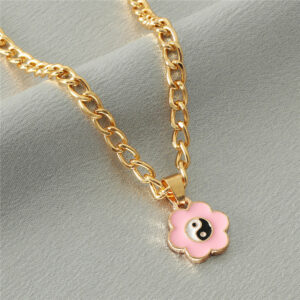 Cute Pink Flower-Shaped Gold Chain Yin Yang Necklace
Cute Pink Flower-Shaped Gold Chain Yin Yang Necklace -
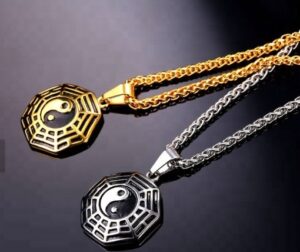 Cool Gold & Silver Bagua Yin Yang Tai Chi Necklace For Men
Cool Gold & Silver Bagua Yin Yang Tai Chi Necklace For Men -
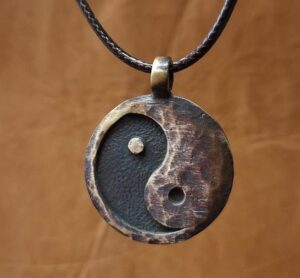 Retro Vintage Aged Alloy Yin Yang Taoist Necklace
Retro Vintage Aged Alloy Yin Yang Taoist Necklace

